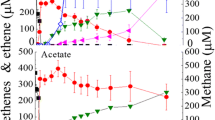Abstract
A stable methanogenic mixed culture was enriched from an industrial environment to utilize chloroacetate as sole carbon and energy source for growth. It immobilized spontaneously on activated charcoal and grew reproducibly on this carrier in a fluidized bed reactor when supplied with an anaerobic mineral salts medium. Substrate disappearance was complete. Methane, CO2 and chloride ions were conclusively identified as the metabolic products and quantified. The growth yield from chloroacetate was about 1 g of protein/mol of carbon. The calculated degradation rate in the fluidized bed reactor was 0.2 to 0.8 mmol/l·h. The first metabolic intermediate from [2−13C]monochloroacetate in portions of biofilm-coated carrier was shown by 13C-NMR to be glycolate, from which 13CO2 and 13CH4 were formed. Glycolate was formed in an oxygen-insensitive hydrolysis, but its conversion to CO2 and CH4 was strictly anaerobic and sensitive to inhibition by bromoethanesulfonate. Degradation of [1-14C]-and [2-14C]-chloroacetate each yielded the same amount of [14C]-methane. We thus presume glycolate to be cleaved to CO2 and H2, which were the substrates for methanogenesis. Dehalogenation was limited to chlorobromo-, iodo- and dichloroacetate. These four compounds and glycolate were utilized as the sole carbon and energy sources by the methanogenic mixed culture.
Similar content being viewed by others
References
Anderson TF (1951) Techniques for the preservation of three dimensional structure in preparing specimens for the electron microscope. Trans N Y Acad Sci 13:130–134
Balch WE, Fox GE, Magrum LJ, Woese CR, Wolfe RS (1979) Methanogens: reevaluation of a unique biological group. Microbiol Rev 43:260–296
Bergmann JG, Sanik J (1957) Determination of trace amounts of chlorine in naphtha. Anal Chem 29:241–243
Conrad R, Phelps TJ, Zeikus JG (1985) Gas metabolism evidence in support of the juxtaposition of hydrogen-producing and methanogenic bacteria in sewage sludge and lake sediments. Appl Environ Microbiol 50:595–601
Cook AM, Hütter R (1981) s-Triazines as nitrogen sources for bacteria. J Agric Food Chem 29:1135–1143
Dickens F (1933) Interaction of halogenacetates and SH compounds. The reaction of halogenacetic acids with glutathione and cysteine. The mechanism of iodoacetate poisoning of glyoxalase. Biochem J 27:1141–1151
Dolfing J, Tiedje JM (1987) Growth yield increase linked to reductive dechlorination in a defined 3-chlorobenzoate degrading methanogenic coculture. Arch Microbiol 149:102–195
Egli C, Scholtz R, Cook AM, Leisinger T (1987) Anaerobic dechlorination of tetrachloromethane and 1,2-dichloroethane to degradable products by pure cultures of Desulfobacterium sp. and Methanobacterium sp. FEMS Microbiol Lett 43:257–261
Egli C, Tschan T, Scholtz R, Cook AM, Leisinger T (1988) Transformation of tetrachloromethane to dichloromethane and carbon dioxide by Acetobacterium woodii. Appl Environ Microbiol 54:2819–2824
Fuchs G, Stupperich E, Eden G (1980) Autotrophic CO2 fixation in Chlorobium limicola. Evidence for the operation of a reductive tricarboxylic acid cycle in growing cells. Arch Microbiol 128:64–71
Goldman P (1965) The enzymatic cleavage of the carbon-fluorine bond in fluoroacetate. J Biol Chem 240:3434–3438
Hanson D (1988) Chemical emergency handling study cites needs. Chem Eng News 66(26):24
Hardman DJ, Slater JH (1981) Dehalogenases in soil bacteria. J Gen Microbiol 123:117–128
Jensen HL (1959) Decomposition of chlorine-substituted organic acids by fungi. Acta Agric Scand 9:421–434
Jensen HL (1963) Carbon nutrition of some microorganisms decomposing halogen-substituted aliphatic acids. Acta Agric Scand 13:404–412
Kiener A, Leisinger T (1983) Oxygen sensitivity of methanogenic bacteria. Syst Appl Microbiol 4:305–312
Koenig G (1975) Chloressigsäuren. In: Bartholomé E, Biekert E, Hellmann H, Lry H, Weigert WM (ed) Ullmanns Enzyklopädie der Technischen Chemie, 4th edn, vol 9. Verlag Chemie, Weinheim, pp 393–403
Lee MJ, Zinder SH (1988) Isolation and characterization of a thermophilic bacterium which oxidizes acetate in syntrophic association with a methanogen and which grown acetogenically on H2−CO2. Appl Environ Microbiol 54:124–129
McInerney MJ, Bryant MP, Pfennig N (1979) Anaerobic bacterium that degrades fatty acids in syntrophic association with methanogens. Arch Microbiol 122:129–135
Motosugi K, Soda K (1983) Microbial degradation of synthetic organochlorine compounds. Experientia 39:1214–1220
Müller P (1988) Effects of pesticides on fauna and flora. In: Pesticides: food and environmental implications Proceedings of a symposium. Neuherberg, 24–27 November 1987, organized by IAEA and FAO. International Atomic Energy Agency, Vienna, pp 11–27
Müller R, Lingens F (1986) Mikrobieller Abbau halogenierter Kohlenwasserstoffe: Ein Beitrag zur Lösung vieler Umweltprobleme? Angew Chem 98:778–787
Muller LL, Jacks TJ (1975) Rapid chemical dehydration of samples for electron microscopic examinations. J Histochem Cytochem 23:107–110
Platen H, Schink B (1987) Methanogenic degradation of acetone by an enrichment culture. Arch Microbiol 149:136–141
Pretsch E, Clerc T, Seibl J, Simon W (1976) Tabellen zur Strukturaufklärung organischer Verbindungen mit spektroskopischen Methoden. Springer, Berlin Heidelberg New York
Schönheit P, Moll J, Thauer RK (1979) Nickel, cobalt, and molybdenum requirement for growth of Methanobacterium thermoautotrophicum. Arch Microbiol 123:105–107
Scholtz R, Schmuckle A, Cook AM, Leisinger T (1987) Degradation of eighteen 1-monohaloalkanes by Arthrobacter sp. strain HA1. J Gen Microbiol 133:267–274
Stieb M, Schink B (1985) Anaerobic oxidation of fatty acids by Clostridium bryantii sp. nov., a sporeforming obligately syntrophic bacterium. Arch Microbiol 140:387–390
Thauer RK, Jungermann K, Decker K (1977) Energy conservation in chemotropic anaerobic bacteria. Bacteriol Rev 41:100–180
Tsang JSH, Sallis PJ, Bull AT, Hardman DJ (1988) A monobromoacetate dehalogenase from Pseudomonas cepacia MBA4. Arch Microbiol 150:441–446
Zehnder AJB, Wuhrmann K (1976) Titanium(III) citrate as a nontoxic oxidation-reduction buffering system for the culture of obligate anacrobes. Science 194:1165–1166
Zehnder AJB, Huser B, Brock TD (1979) Measuring radioactive methane with the liquid scintillation counter. Appl Environ Microbiol 37:897–899
Zinder SH, Koch M (1984) Non-aceticlastic methanogenesis from acetate: acetate oxidation by a thermophilic syntrophic coculture. Arch Microbiol 138:263–272
Author information
Authors and Affiliations
Rights and permissions
About this article
Cite this article
Egli, C., Thüer, M., Suter, D. et al. Monochloro- and dichloroacetic acids as carbon and energy sources for a stable, methanogenic mixed culture. Arch. Microbiol. 152, 218–223 (1989). https://doi.org/10.1007/BF00409654
Received:
Accepted:
Issue Date:
DOI: https://doi.org/10.1007/BF00409654




